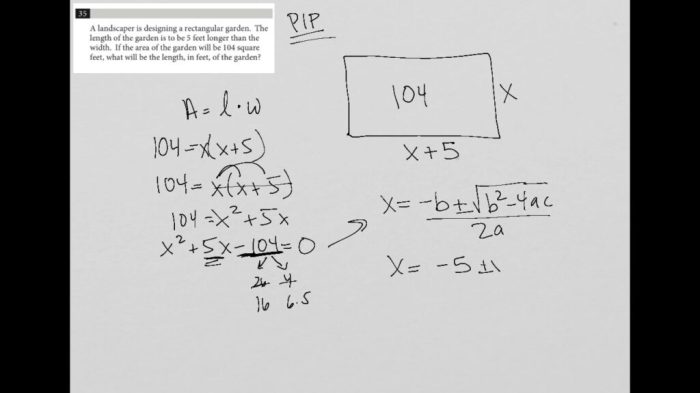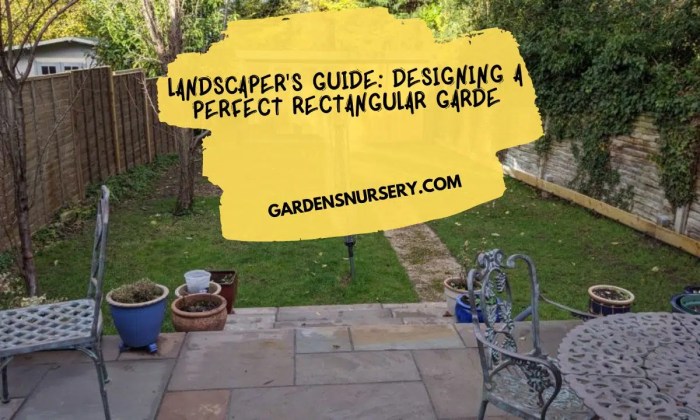A landscaper is designing a rectangular garden, and this comprehensive guide delves into the intricacies of creating visually stunning and functional outdoor spaces. From design considerations to plant selection and maintenance, this guide empowers landscapers with the knowledge and techniques to transform any rectangular space into a thriving oasis.
Rectangular gardens offer unique design opportunities, allowing landscapers to explore various layouts, incorporate focal points, and maximize space utilization. This guide provides expert insights into the factors that influence garden design, including size, shape, orientation, and location, ensuring that the garden seamlessly integrates with its surroundings.
Design Considerations: A Landscaper Is Designing A Rectangular Garden

When designing a rectangular garden, it is essential to consider various factors that will influence its functionality and aesthetics. These include:
- Size and Shape:Determine the optimal dimensions of the garden based on the available space and intended usage. Consider the length, width, and overall shape to ensure it complements the surrounding landscape.
- Orientation:Choose the best orientation for the garden to maximize sunlight exposure and drainage. Consider the direction of sunlight throughout the day and the slope of the land.
- Location:Select a location that is accessible, has good drainage, and is protected from strong winds. Proximity to water sources and existing structures should also be taken into account.
Layout and Planning

The layout of a rectangular garden can significantly impact its visual appeal and functionality. Different layout options include:
- Symmetrical:A symmetrical layout creates a formal and balanced appearance, with elements arranged evenly on both sides of a central axis.
- Asymmetrical:An asymmetrical layout introduces visual interest by placing elements in an unbalanced manner, creating a more informal and dynamic look.
- Formal:A formal layout adheres to strict geometric principles, with straight lines, right angles, and symmetrical arrangements. It often incorporates hardscaping elements such as paths, patios, and fountains.
Planning the garden involves dividing it into sections, creating pathways for accessibility, and incorporating focal points to draw the eye.
Plant Selection

When selecting plants for a rectangular garden, consider the following factors:
- Size and Shape:Choose plants that are appropriate for the size of the garden and complement its shape. Consider the height, width, and growth habit of each plant.
- Color:Plan the arrangement of plants to create visual interest and balance through color combinations. Consider the blooming periods and foliage colors of different species.
- Blooming Period:Select plants with varying blooming periods to ensure year-round interest. This will create a dynamic display that evolves throughout the seasons.
Group plants effectively to maximize space utilization and create focal points. Use tall plants as backdrops, medium-sized plants for mid-level interest, and ground covers or trailing plants for borders.
Construction and Maintenance

Constructing a rectangular garden involves preparing the soil, laying out the beds, and installing edging. Use raised beds if drainage is an issue or to extend the growing season.Maintenance is crucial to keep the garden healthy and thriving. Regular watering, fertilizing, and pest control are essential.
Mulching helps retain moisture, suppress weeds, and regulate soil temperature. Hardscaping elements such as paths and patios provide accessibility and structure to the garden. Lighting can enhance its nighttime appeal and extend its usability.
FAQ Insights
What are the key factors to consider when designing a rectangular garden?
Size, shape, orientation, location, sunlight, drainage, and accessibility.
How can I create a balanced and visually appealing layout for my rectangular garden?
Use symmetrical or asymmetrical designs, divide the garden into sections, create pathways, and incorporate focal points.
What are some recommended plant species for rectangular gardens?
Consider size, shape, color, blooming period, climate, soil conditions, and desired aesthetic.
What are the essential steps involved in constructing a rectangular garden?
Prepare the soil, lay out the beds, install edging, and incorporate landscaping techniques like mulching, hardscaping, and lighting.